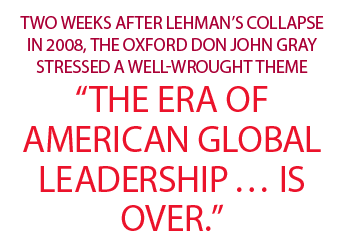Two weeks after Lehman’s collapse, the Oxford don John Gray stressed a well-wrought theme: “The era of American global leadership … is over.” Actually, generic Declinism needs neither date nor trigger. If it isn’t repeated by the same prophet 10, 20 years down the lane, it is generational. So a few months before the Crash of 2008, the youngish Parag Khanna, of the New America Foundation in Washington, intoned, “America’s standing in the world remains in steady decline.”
The disease was “imperial overstretch,” and the price was the weakening of “America’s armed forces” through overuse. That had a familiar ring–and so did the warning in The New York Times Magazine that: “We are competing–and losing–in a geopolitical marketplace alongside the world’s other superpowers.”
Who were they?
Near the end of naughts, the new Declinist consensus had settled on Asia–on China first and foremost, on India second, and on Russia and Brazil somewhere down the line. These were the fabled BRIC countries, the quartet that would inherit the world. The driver of the new dispensation was an old one. The United States was losing the growth race to those who were forging ahead at double-digit speed.
In mid-decade, a former Japan booster like Clyde Prestowitz merely changed the names of the candidates in his Three Billion New Capitalists: The Great Shift of Wealth and Power to the East. The chapter headings tell the tale. In this new world, things would be “Made in China” and “Serviced in India.” And America was on the “Road to Ruin.”
A former editor of The Economist, Bill Emmott, saw geopolitics following economics, with power growing not from the barrel of a gun but from GDP and trade statistics. Wasn’t the World Bank predicting that China and India might triple their output in a matter of years? By the late 2020s, China would overtake the United States. And so, good-bye, America. How the Power Struggle between China, India, and Japan Will Shape Our Next Decade, proclaimed the subtitle of his book Rivals. Japan, stuck in real decline, was in again, and the United States was out.
The Newsweek International editor Fareed Zakaria put an original gloss on an old story in 2008. It wasn’t that America was decrepit and declining, as many previous authors had argued. America still had many assets on the ledger. Others were simply growing faster–at an awesome, unbreakable speed. A billion people in India, 1.3 billion in China–how could so much mass and momentum be stopped?
Hence it was the “rise of the rest” that would dwarf the United States. And the future would belong to the “post-American world.” Two years later, the historian Niall Ferguson classified the United States as a “departing” power, up against the “arriving” power that was China. Exit Gulliver, enter the Middle Kingdom. Finally for good?
Not yet. Four years after the Crash of 2008, The Economist put a strapping Uncle Sam on its cover, cheering him as “The Comeback Kid.” Inside, the weekly announced, “Led by its inventive private sector, the economy is remaking itself. Old weaknesses are being remedied and new strengths discovered, with an agility that has much to teach to stagnant Europe and dirigiste Asia.” The United States was on the up; Europe and Asia were treading water.
Earlier in the year, The American Interest, showing Uncle Sam punching with an oversized boxing glove, had put the same title–“The Comeback Kid”–on its cover. Inside, the journal presented articles like “How America Is Poised to Retake the Lead in the World Economy,” “The Once and Future Dollar,” and “The Population Boon.” Foreign Affairs put the “Demise of the Rest” on its cover. Inside, the title of the lead piece read, “Broken BRICs: Why the Rest Stopped Rising.”
Highlighting the tumbling growth rates of the quartet, the author added, “None of this should be surprising because it is hard to sustain rapid growth for more than a decade.”
Become a Saturday Evening Post member and enjoy unlimited access. Subscribe now




